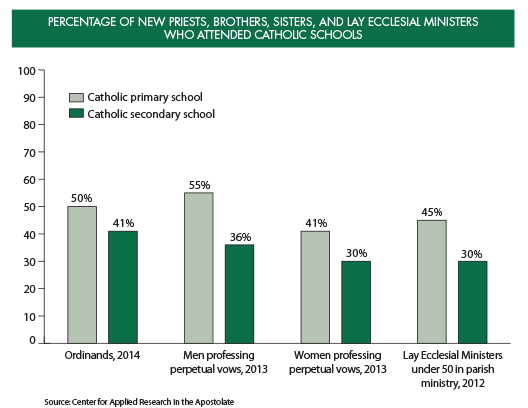CARA researcher Mark Gray prepared a snapshot of the present and probable future effect of Catholic schools on religious life, which was presented at the U.S. Conference of Catholic Bishops’ annual meeting in November. Here are excerpts from the report, which is based upon a variety of past CARA research:
- A CARA 2012 survey of Catholic teenagers, ages 14 to 17 discovered that 14 percent had attended a Catholic school and 18 percent had some Catholic schooling plus parish religious education, but two in three had no exposure to Catholic schools at all.
- Weekly Mass attendance among members of the Millennial Generation (born 1982 or later) is 34 percent for those who attended a Catholic primary school and 39 percent for those who attended a Catholic secondary school, but only 5 percent for those who never attended a Catholic school.
- The proportion of never-married Millennial male Catholics who ever considered becoming a priest or brother was 26 percent among those who attended a Catholic primary or secondary school, but only 9 percent for those with no Catholic schooling.
- Similarly, the percentages of young Millennial Catholic females who ever considered becoming a sister or nun were 13 percent among those who attended a Catholic primary school, 16 percent for secondary school, but only 6 percent for those who never attended Catholic school.
From the standpoint of religious vocations, the accompanying graphic illustrates the impact of Catholic schools. While only 37 percent of Post-Vatican II Catholics (born 1961–1981) and 23 percent of Millennial Catholics attended a Catholic school, half or more of new priests and brothers attended Catholic primary schools, as did 41 percent of new sisters and 45 percent of young lay ecclesial ministers.
Catholic schools are facing challenges that are both demographic (i.e., fertility and mobility) and economic (i.e., recession, financing, and the impact of tuition costs on parental decisions). Some of the most recent decline in Catholic school students, however, is a function of fewer Catholic children and schools:
- For example, in 2000 there were 213,723 students enrolled in the fourth grade in the 6,923 Catholic schools in the United States. By comparison, in 2013 there were 140,680 fourth graders in 5,472 schools.
- Catholic schools overall are also experiencing slow year-to-year losses by class. For example, the 218,981 kindergarten students in 2001 had dropped to 167,007 eighth graders in 2009 and 136,524 high school seniors in 2013.
A national random sample of Catholic school parents interviewed by CARA in 2006 indicated these as the leading “very important” factors in their option for Catholic education: quality religious education (81 percent), safe environment (79 percent), quality academic instruction (78 percent), discipline and order (65 percent), sense of community (61 percent), affordable tuition (50 percent).
The one factor that dissuades Catholic parents the most from enrolling children in Catholic schools is tuition costs. This was “somewhat” or “very much” a consideration for 50 percent of parents who enrolled their children in Catholic schools and 54 percent of those who did not. Insuffi cient tuition assistance was a factor for 26 percent of enrolling and 47 percent of non-enrolling parents.
I mellemtiden er Det Europæiske Lægemiddelagentur (EMA) stadig ved at gennemgå Merck-tabletterne. Efter en stigning i antallet af tilfælde af coronavirus 20 mg udstedte EU’s tilsynsmyndighed i november en anbefaling om brugen af tabletterne til raske voksne.
The report explains that, “In the last ten years, inflation-adjusted elementary school tuitions have increased by 37 percent and high school tuition by 82 percent.” Thus, “Tuition costs, especially since the Great Recession of 2009, have likely been a substantial important factor in declining enrollments.” The national average Catholics school tuition rates in 2013 were $3,673 at the elementary and $9,622 at the secondary school level.
Hispanic Catholics are much more numerous among Catholics of child-bearing age than older generations. Yet they are disproportionately underserved by Catholic schools. In school year 2013-2014:
- There were 2,106,260 Catholic children at preschool ages 3 to 4, of whom 62 percent were Hispanic, but only 8 percent of all Catholic children this age attended Catholic school.
- There were 9,634,560 Catholic children at primary school ages 5 to13, of whom 57 percent were Hispanic, but only 13 percent of all Catholic children this age attended Catholic school.
- There were 4,984,080 Catholic teenagers at secondary school ages 14 to 18, of whom 50 percent were Hispanic, but only 11 percent of all Catholic children this age attended Catholic school.
For further information on “Catholic Schools in the United States in the 21st Century: Importance in Church Life, Challenges, and Opportunities,” a CARA report for the USCCB Secretariat of Education, June 2014, contact Mark M. Gray at CARA.
This article was originally published in The Cara Report (Vol. 20, No.3 / Winter 2015) by the Center for Applied Research in the Apostolate, Georgetown University. Shared with permission. For more information on CARA, please visit cara.georgetown.edu.

